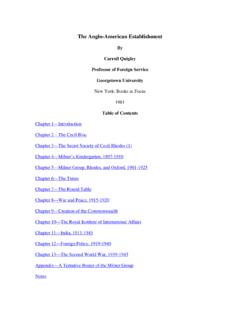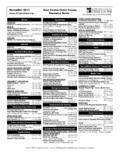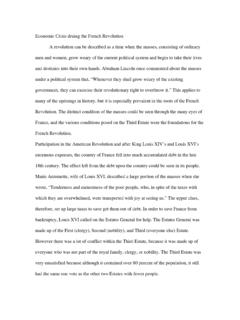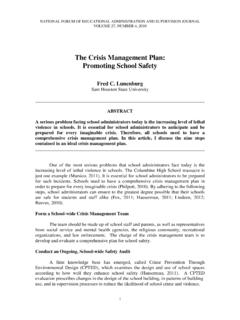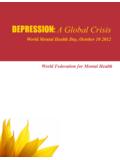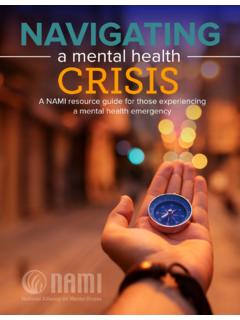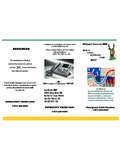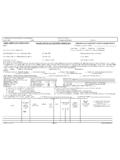Transcription of The Financial Crisis in the US: Key Events, Causes …
1 RESEARCH PAPER 09/34 22 APRIL 2009 The Financial Crisis in the US: key events, Causes and responses The current Financial Crisis started in the US housing market in 2007. The Crisis spread across the world and severely damaged the economies of many countries, including the US, and reached a new level in September 2008 as a number of prominent US-based Financial institutions, including AIG and Lehman Brothers, collapsed. This Research Paper first examines the underlying Causes of the Crisis in the US. In particular, it examines the emergence and collapse of the housing bubble and the significance of the complex Financial instruments that transformed an asset price correction into a significant domestic and global economic downturn.
2 The main focus is the response of governing institutions in the US. Looking at responses before and after September 2008 drawing comparison with the UK where relevant this Paper examines the actions of a wide range of institutions including the Federal Reserve, US Treasury, Congress, Securities and Exchange Commission and Federal Deposit Insurance Corporation. John Marshall BUSINESS AND TRANSPORT SECTION HOUSE OF COMMONS LIBRARY RESEARCH PAPER 09/34 2 Recent Library Research Papers include.
3 09/19 Small Business Rate Relief (Automatic Payment) Bill [Bill 13 of 2008-09] 09/20 Economic Indicators, March 2009 09/21 Statutory Redundancy Pay (Amendment) Bill [Bill 12 of 2008-09] 09/22 Industry and Exports ( Financial Support) Bill [Bill 70 of 2008-09] 09/23 Welfare Reform Bill: Committee Stage Report 09/24 Royal Marriages and Succession to the Crown (Prevention of Discrimination) Bill [Bill 29 of 2008-09] 09/25 Fuel Poverty Bill [Bill 11 of 2008-09] 09/26 Unemployment by Constituency, February 2009 09/27 Coroners and Justice Bill.
4 Committee Stage Report 09/28 Geneva Conventions and United Nations Personnel (Protocols) Bill [HL] [Bill 69 of 2008-09] 09/29 Members pay and the independent review process 09/30 Economic Indicators, April 2009 09/31 Members since 1979 09/32 Unemployment by Constituency, March 2009 09/33 Apprenticeships, Skills, Children and Learning Bill.
5 Committee Stage Report Research Papers are available as PDF files: to members of the general public on the Parliamentary web site, URL: within Parliament to users of the Parliamentary Intranet, URL: Library Research Papers are compiled for the benefit of Members of Parliament and their personal staff. Authors are available to discuss the contents of these papers with Members and their staff but cannot advise members of the general public. We welcome comments on our papers; these should be sent to the Research Publications Officer, Room 407, 1 Derby Gate, London, SW1A 2DG or e-mailed to ISSN 1368-8456 RESEARCH PAPER 09/34 Summary of main points In September and October 2008, the US suffered a severe Financial dislocation that saw a number of large Financial institutions collapse.
6 Although this shock was of particular note, it is best understood as the culmination of a credit crunch that had begun in the summer of 2006 and continued into 2007. The US housing market is seen by many as the root cause of the Financial Crisis . Since the late 1990s, house prices grew rapidly in response to a number of contributing factors including persistently low interest rates, over-generous lending and speculation. The bursting of the housing bubble, in addition to simultaneous crashes in other asset bubbles, triggered the credit Crisis . However, it was the complex web of Financial innovations that had purportedly been employed to reduce risk which ensured that the Crisis spread across the Financial markets and into the real economy.
7 In particular, all manner of profit-seeking Financial institutions used a complex Financial process characterised by highly leveraged borrowing, inadequate risk analysis and limited regulation to bet on one outcome a bet which proved to be misguided when asset prices collapsed. Prior to September 2008, the response from governing institutions in the US primarily sought to address liquidity concerns, stimulate demand and prevent mortgage foreclosures. The main policy responses included: the Federal Reserve (Fed) lowering interest rates as well as a introducing number of liquidity-enhancing schemes to abate the emerging credit Crisis ; the orderly takeover of failed investment bank Bear Stearns; and legislation seeking to stimulate demand and mitigate mortgage foreclosure.
8 After the shocks of September and October 2008, where credit and risk interest rate spreads shot up and the systemic nature of the Crisis became apparent, a new approach was adopted. In addition to the Fed, the US Treasury became a key body in administering the Emergency Economic Stabilization Act passed by Congress in October 2008. The central features of the post-September response included: the Fed and US Treasury decision not to bail out investment bank Lehman Brothers; Treasury-administered capital injections into troubled Financial institutions in exchange for preferred stock and common equity stakes; a sequence of bailouts by the Fed and Treasury for the insurance giant AIG; continuing efforts from the Fed to lower interest rates and increase liquidity; the unprecedented purchase of mortgage-backed securities and Treasury bills as part of the Fed s policy of credit easing.
9 The temporary suspension of the short-selling of Financial institutions by the Securities and Exchange Commission; the Homeowner Affordability and Stability Plan, which permitted struggling homeowners to refinance their mortgages; and the passage of the $787bn American Recovery and Reinvestment Act designed to reinvigorate demand in the US economy. This paper contains appendices providing a glossary of key concepts and a list of acronyms. 3 RESEARCH PAPER 09/34 4 RESEARCH PAPER 09/34 CONTENTS I Introduction 7 II Causes of the Financial turmoil 10 A.
10 The US housing market 10 1. Creation of a housing bubble 10 2. The collapse of the bubble 13 B. The role of the Financial industry 15 1. The web of Financial instruments 15 2. The housing crash and the finance industry 20 III Policy responses 26 A. Responses before September 2008 26 1. The Federal Reserve 26 2. Legislation 28 3. US Treasury 29 4. Other regulatory agencies 29 5. Summary 29 B. Responses after September 2008 30 1.


